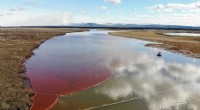
Wetenschap
China wil eigen Yellowstone bouwen op Tibetaans plateau
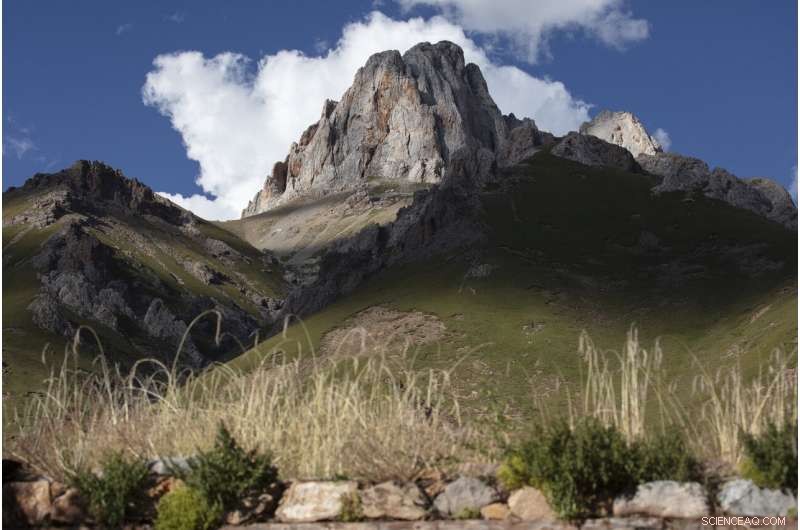
Pieken reiken naar de hemel in Angsai, een gebied in de Sanjiangyuan-regio in de West-Chinese provincie Qinghai op zondag, 25 augustus 2019. Geringd door 's werelds hoogste bergketens, de regio die lang bekend stond als 'het dak van de wereld' bevindt zich nu in het vizier van China's nieuwste moderniseringspoging. Maar deze keer, de Chinese regering wil grenzen stellen aan de groei van de regio om haar eigen versie van een van de meest trotse erfenissen van de VS te implementeren:een nationaal parksysteem. (AP Foto/Ng Han Guan)
Er is een bouwhausse op het Tibetaanse plateau, een van 's werelds laatste afgelegen plaatsen. Bergen die lang gekroond zijn door slingers van wapperende gebedsvlaggen - een traditionele landschapszegen - zijn onlangs bekroond met uitgestrekte stalen hoogspanningskabels. 's Nachts, de verlichte borden van Sinopec-tankstations werpen een rode gloed over nieuw aangelegde snelwegen.
Omringd door 's werelds hoogste bergketens, de regio die lang bekend stond als "het dak van de wereld" is nu in het vizier van China's nieuwste moderniseringspoging, gekenmerkt door het vermenigvuldigen van wolkenkrabbers en het uitbreiden van hogesnelheidslijnen.
Maar deze keer, er is een verschil:de Chinese regering wil ook grenzen stellen aan de groei van de regio om haar eigen versie te ontwerpen van een van de meest trotse erfenissen van de VS:een nationaal parksysteem.
In augustus, beleidsmakers en wetenschappers uit China, de Verenigde Staten en andere landen bijeen in Xining, hoofdstad van de provincie Qinghai, om de plannen van China te bespreken om een verenigd parksysteem te creëren met duidelijke normen voor het beperken van ontwikkeling en het beschermen van ecosystemen.
De economie van het land is de afgelopen 40 jaar enorm gegroeid, maar de prioriteiten worden nu uitgebreid met het behoud van belangrijke natuurlijke hulpbronnen, zegt Zhu Chunquan, de Chinese vertegenwoordiger van de Internationale Unie voor het behoud van de natuur, een in Zwitserland gevestigde wetenschappelijke groep.
"Het is heel dringend om zo snel mogelijk de plaatsen te identificeren, de ecosystemen en andere natuurlijke kenmerken" te beschermen, zegt Zhu.

Een Tibetaanse vrouw zorgt voor een kind in Angsai, een gebied in de Sanjiangyuan-regio in de West-Chinese provincie Qinghai op zondag, 25 augustus 2019. Een belangrijke vraag doemt op over het nationale parkenproject van het land:kan China de doelen van natuurbehoud en toerisme combineren, terwijl het levensonderhoud en de cultuur van de ongeveer 128, 000 mensen die binnen of nabij de grenzen van het park wonen, velen van hen Tibetaans? (AP Foto/Ng Han Guan)
Onder andere doelen, China wil zijn eigen Yellowstone bouwen op het Tibetaanse plateau.
Zhu is lid van een adviescommissie die input levert over de ontwikkeling van China's ontluikende nationale parksysteem, zal naar verwachting officieel worden onthuld in 2020. Chinese functionarissen hebben ook Amerikaanse nationale parken bezocht, waaronder Yellowstone en Yosemite, en input gevraagd van verschillende organisaties, waaronder het in Chicago gevestigde Paulson Institute en de Nature Conservancy.
De ambitie om een verenigd parksysteem te creëren, vertegenwoordigt "een nieuwe en serieuze poging om de biodiversiteit en het natuurlijke erfgoed van China te beschermen, ', zegt ecoloog Stuart Pimm van Duke University.
Een van de eerste pilotparken komt in Qinghai, een uitgestrekte regio in het westen van China die grenst aan Tibet en veel van zijn culturele erfenis deelt. Het gebied is ook de thuisbasis van iconische en bedreigde diersoorten als de sneeuwluipaard en de Chinese bergkat, en omvat de bovenloop van drie van Azië's grote waterwegen:de Yangtze, Gele en Mekong rivieren.
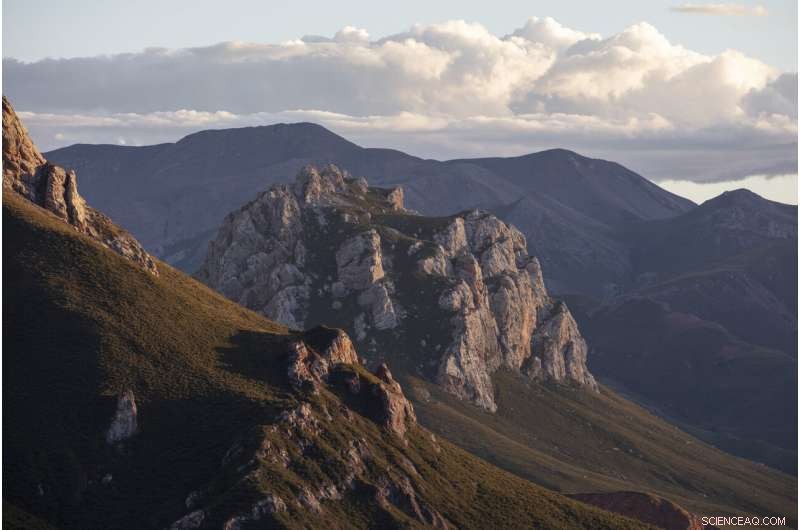
Wolken hangen boven het bergachtige landschap in Angsai, een gebied in de Sanjiangyuan-regio in de West-Chinese provincie Qinghai op zondag, 25 augustus 2019. China wil zijn eigen Yellowstone bouwen op het Tibetaanse plateau. (AP Foto/Ng Han Guan)
"Dit is een van de meest bijzondere regio's in China, in de wereld, " zegt Lu Zhi, een natuurbeschermingsbioloog van de Universiteit van Peking die twee decennia in Qinghai heeft gewerkt.
Terwijl elders op het Tibetaanse plateau in een razend tempo wordt gebouwd, de regering is al gestopt met het afgeven van mijnbouw- en waterkrachtvergunningen in deze regio.
Maar een belangrijke vraag doemt op over het project:kan China de doelen van natuurbehoud en toerisme combineren, terwijl het levensonderhoud en de cultuur van de ongeveer 128, 000 mensen die binnen of nabij de grenzen van het park wonen, velen van hen Tibetaans?
"China heeft een dichte bevolking en een lange geschiedenis, "Zegt Zhu. "Een van de unieke kenmerken van de nationale parken van China is dat er lokale mensen in of in de buurt wonen."
Yellowstone wordt algemeen beschouwd als 's werelds eerste nationale park. Nadat het in 1872 was opgericht, de Amerikaanse regering dwong de indianen die in het gebied woonden om zich buiten de parkgrenzen te vestigen, in overeenstemming met het 19e-eeuwse idee dat bescherming van de wildernis betekende dat de natuur los stond van mensen. Maar landen die in de 21e eeuw parksystemen proberen op te zetten, moeten nu overwegen hoe de lokale bevolking het beste bij hun planning kan worden betrokken.
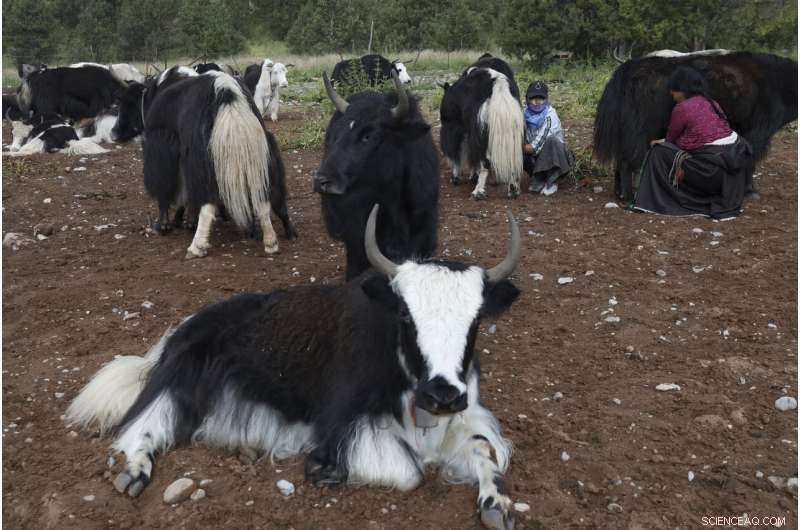
Tibetaanse vrouwen melken hun yaks in Angsai, een gebied in de Sanjiangyuan-regio in de West-Chinese provincie Qinghai op zondag, 25 augustus 2019. Qinghai is een uitgestrekte regio in het westen van China die grenst aan Tibet en deelt veel van zijn culturele erfenis. (AP Foto/Ng Han Guan)
"Uitzoeken hoe je tegelijkertijd ecologisch behoud en ondersteuning voor de gemeenschappen kunt bereiken - dat is het meest gecompliceerde probleem dat je hebt, " zegt Jonathan Jarvis, een voormalig directeur van de U.S. National Park Service en nu een professor aan de Universiteit van Californië, Berkeley, die het Qinghai-pilootpark heeft bezocht, genaamd Sanjiangyuan.
China heeft eerder uitgebreide hervestigingsprogramma's ondernomen om land vrij te maken voor grote infrastructuurprojecten, zoals Three Gorges Dam en het Zuid-naar-Noord Water Transfer Project. Deze hervestigingen lieten veel boeren in nieuwe huizen achter zonder geschikte landbouwgronden of toegang tot ander levensonderhoud.
Maar bij de ontwikkeling van de nationale parken, the government is giving conservation-related jobs to at least a swath of people living in Sanjiangyuan to stay and work on their land. The "One Family, One Ranger" program hires one person per family for 1800 yuan a month ($255) to perform such tasks as collecting trash and monitoring for poaching or illegal grazing activity.
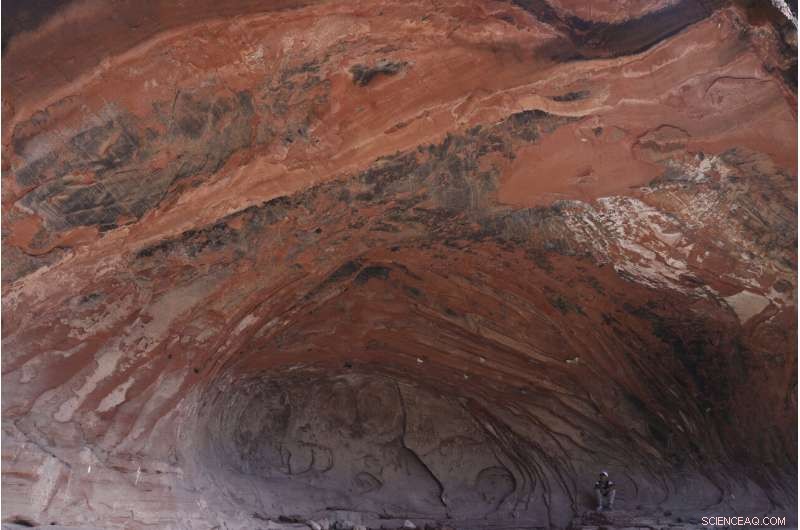
A Tibetan youth sits at the base of a natural cave formation in Angsai, an area inside the Sanjiangyuan region in western China's Qinghai province on Sunday, Aug. 25, 2019. China has previously undertaken vast resettlement programs to clear land for large infrastructure projects, but in developing the national parks, the government is giving conservation-related jobs to at least a swath of people living in Sanjiangyuan to stay and work on their land. (AP Photo/Ng Han Guan)
It's difficult to interview residents in China's ethnic borderlands like Qinghai, due to restrictions on journalists that make it hard to travel widely or freely in those areas. Regions with large ethnic and religious minorities, including all Tibetan areas, are subject to heightened political and religious controls.
But a few people living in Angsai, a Tibetan village located within the new Qinghai park, were willing to speak, although it's not possible to determine if their experiences are typical.
A-Ta is a Tibetan herder whose income largely comes from raising yaks and collecting caterpillar fungus, a folk medicine taken as a purported aphrodisiac or for respiratory problems. He also leads a team of trash collectors, traveling as much as 34 kilometers (21 miles) a day to comb the hillsides for plastic bottles and other waste as part of the "One Family, One Ranger" program.

A-Ta, at right stands near his father in their home in Angsai, an area inside the Sanjiangyuan region in western China's Qinghai province on Monday, Aug. 26, 2019. A-Ta, a Tibetan herder whose income largely comes from raising yaks and collecting caterpillar fungus, also leads a team of trash collectors traveling as much as 34 kilometers (21 miles) a day to comb the hillsides for plastic bottles and other waste, as part of the "One Family, One Ranger" program. (AP Photo/Ng Han Guan)
"I am living in this land, my living is relying on this land, " hij zegt, as his sister heats a kettle in their modest home. A poster showing the faces of China's past leaders and current Communist Party general secretary, Xi Jinping, hangs on the wall.
A-Ta says he is grateful for work that allows his family to stay on their land, even as people in other parts of Qinghai have had to leave. His own son is employed leading a relocation program for "a huge population of nomads" in Dzarto, a county in southern Qinghai.
"I love this land very much, " he says. "I always motivate and encourage people to protect the environment and contribute to the conservation work."
Kunchok Jangtse is a Tibetan herder who also earns money cleaning up rubbish through the "One Family, One Ranger" program.
He has an additional volunteer position through the Chinese nonprofit Shanshui—the name means "mountain, water"—installing and maintaining motion-activated camera traps, which help scientists monitor endangered species in Qinghai.
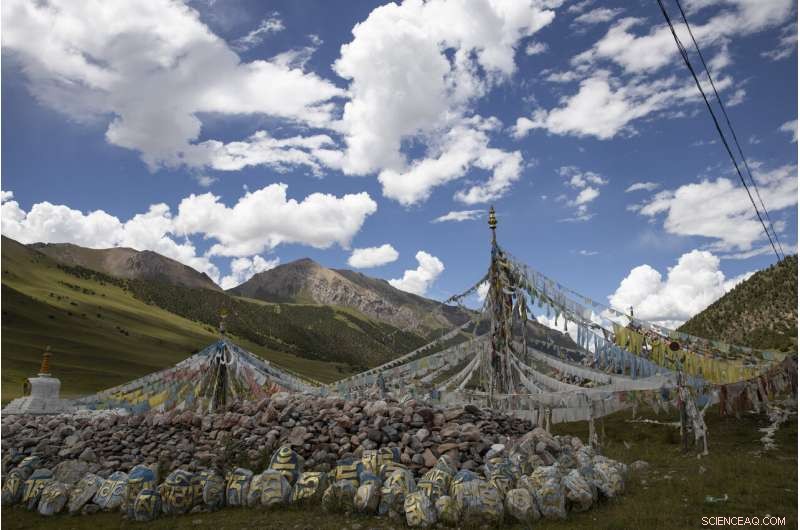
Tibetan prayer flags are seen during a clear day in Angsai, an area inside the Sanjiangyuan region in western China's Qinghai province on Monday, Aug. 26, 2019. Qinghai is a vast region in western China abutting Tibet and shares much of its cultural legacy. (AP Photo/Ng Han Guan)
As he affixes a camera trap to a thin tree trunk, he explains, "The reason why it has to be installed in this location is because this is the main migration route of the majority of wild animals."
Such camera traps have captured rare footage of snow leopards and Chinese mountain cats, including mothers and their cubs playing near a temporary den.
Kunchok Jangtse says the work of protecting the environment, including reporting illegal poaching activity, is important.
"Our religion is connected with wild animals, because wild animals have a consciousness and can feel love and compassion—therefore, we protect wild-animals, " hij zegt.
From his main work raising livestock and collecting caterpillar fungus, Kunchok Jangtse says he can make about 20, 000 yuan ($2, 830) a year. He is grateful for the additional income from the ranger program, but mainly hopes his other livelihood won't be impeded—and that he won't eventually be forced to leave.
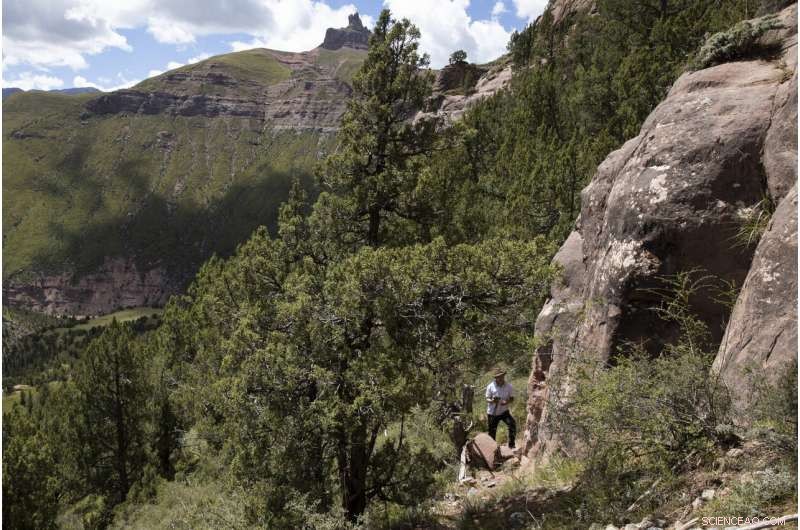
Kunchok Jangtse, a Tibetan herder who also instals and maintains motion-activated cameras, works on a camera in Angsai, an area inside the Sanjiangyuan region in western China's Qinghai province on Tuesday, Aug. 27, 2019. His work helps scientists monitor endangered species. "I'm not a highly educated person, and I am very concerned it may bring many difficulties in my life if I would switch my job and move to another place, " he says. (AP Photo/Ng Han Guan)
"I'm not a highly educated person, and I am very concerned it may bring many difficulties in my life if I would switch my job and move to another place, " hij zegt.
The question of local people's culture and livelihoods is one of the top concerns that former U.S. National Park Service director Jarvis says China has to wrestle with, along with establishing laws and funding.
"They need a legal framework that defines what a park is, " Jarvis says. "And they need sustainable funding."
The creation of protected areas is not a new idea in China. In feite, roughly 15% of the country's land already is assigned to a bewildering patchwork of local and regional parks. But many existing reserves are simply parks on paper, run by various agencies without enforceable guidelines.
In tegenstelling tot, the national parks system is being designed from the ground-up to incorporate global best practices and new science.
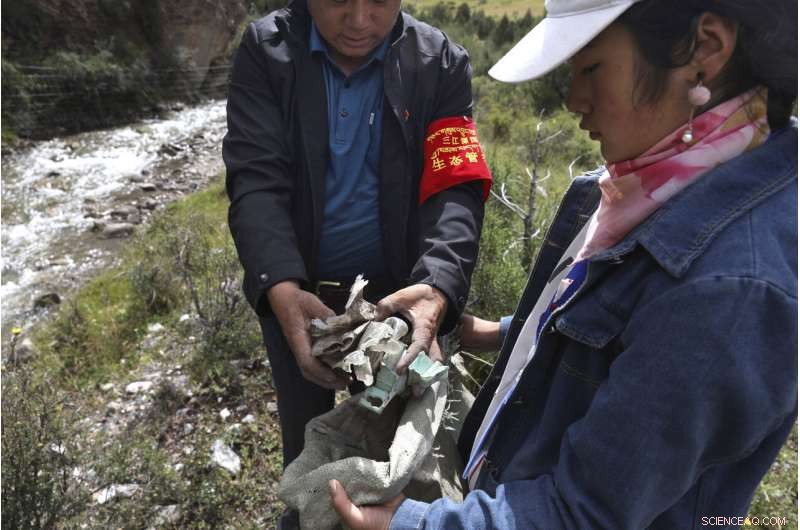
A-Ta, a Tibetan herder whose income largely comes from raising yaks and collecting caterpillar fungus, places refuse in a bag as he leads his team of trash collectors in Angsai, an area inside the Sanjiangyuan region in western China's Qinghai province on Monday, Aug. 26, 2019. His team travels as much as 34 kilometers (21 miles) a day to comb the hillsides for plastic bottles and other waste, as part of the "One Family, One Ranger" program. "I am living in this land, my living is relying on this land, " he says. (AP Photo/Ng Han Guan)
In his office in Beijing, Ouyang Zhiyun, deputy director at the Chinese Academy of Sciences' Research Center for Eco-Environmental Sciences, pores over hundreds of carefully shaded maps of mainland China that denote priority areas for protecting threatened and endangered species, as well as "eco-system services, " like safeguarding water supplies and limiting soil erosion.
The question isn't just how much total land you're protecting, but which lands you're protecting, he notes.
Onlangs, Ouyang was the lead scientist for China's sweeping "national ecosystems assessment, " which used 20, 000 satellite images and 100, 000 field surveys to examine how China's land changed between 2000 and 2010, with some of the findings published in the journal Science in 2016. One resulting statistic:China's urban area increased 28% during that period.
-
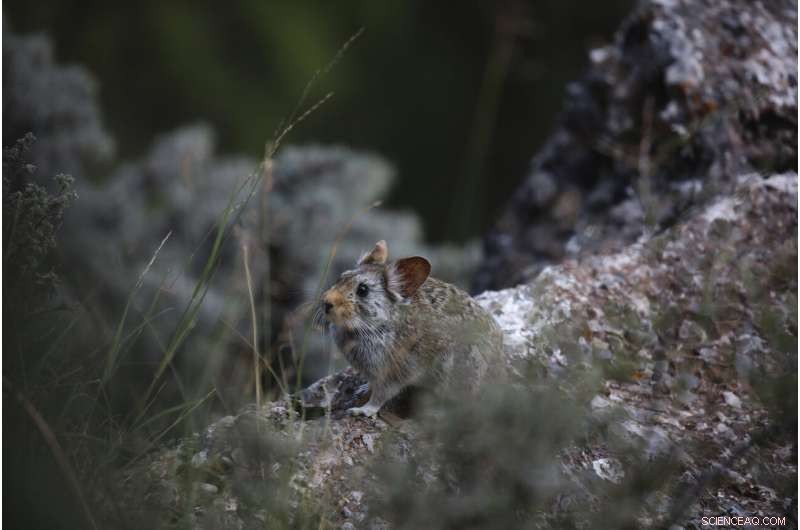
A Glover's Pika surveys its surrounding in Angsai, an area inside the Sanjiangyuan region in western China's Qinghai province on Tuesday, Aug. 27, 2019. (AP Photo/Ng Han Guan)
-
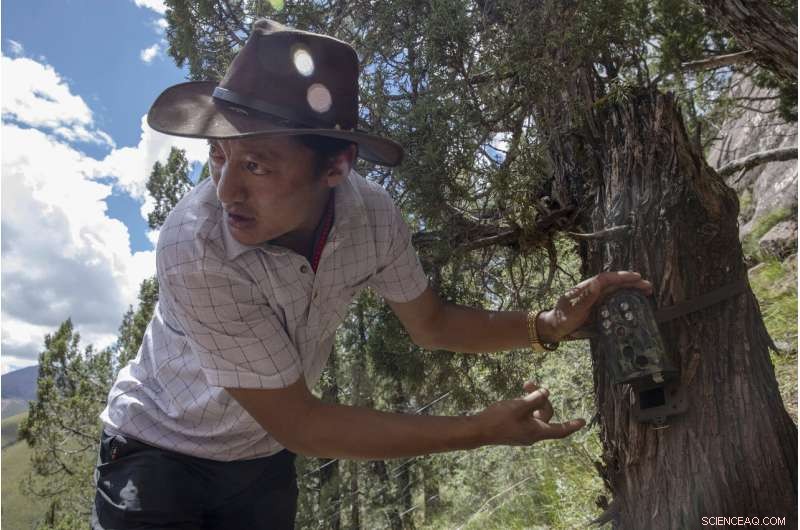
Kunchok Jangtse positions a camera trap in Angsai, an area inside the Sanjiangyuan region in western China's Qinghai province on Tuesday, Aug. 27, 2019. The Tibetan herder also has a job installing and maintaining the motion-activated cameras, which help scientists monitor endangered species in the area. "Our religion is connected with wild animals, because wild animals have a consciousness and can feel love and compassion—therefore, we protect wild-animals, " he says. (AP Photo/Ng Han Guan)
-
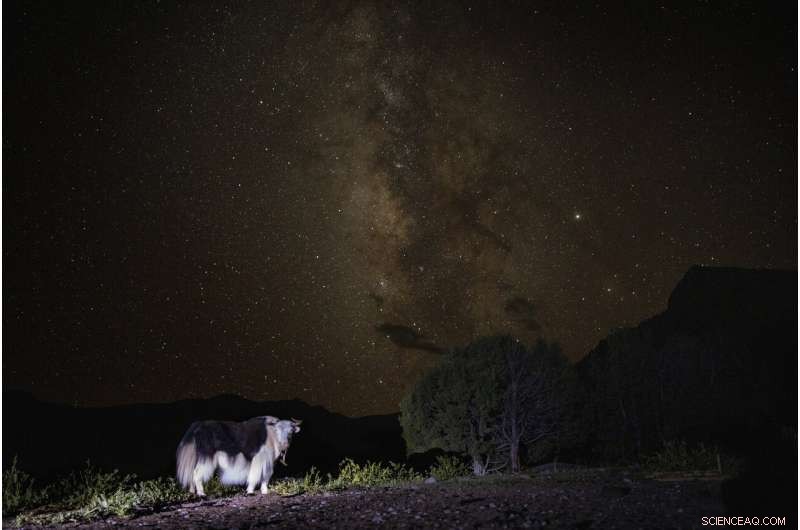
The Milky Way glows behind a yak in Angsai, an area inside the Sanjiangyuan region in western China's Qinghai province on Monday, Aug. 26, 2019. "This is one of the most special regions in China, in the world, " says Lu Zhi, a Peking University conservation biologist who has worked in Qinghai for two decades. (AP Photo/Ng Han Guan)
-
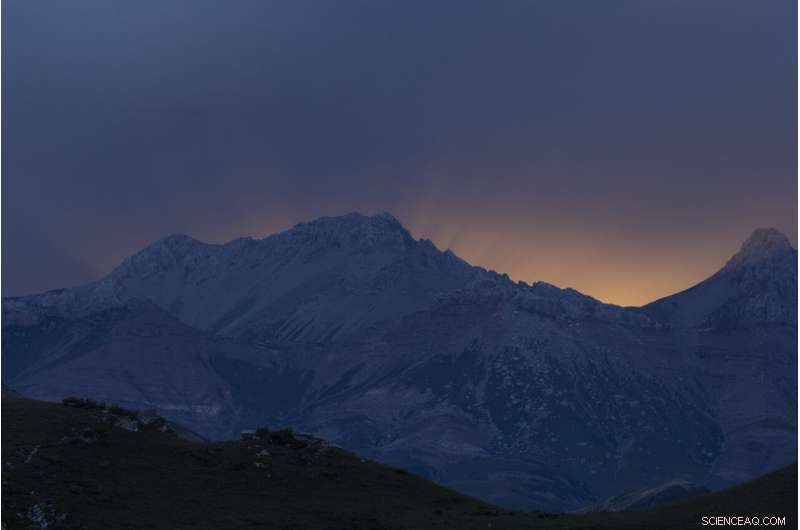
A sunset casts rays of light over the top of a mountain range in Angsai, an area inside the Sanjiangyuan region in western China's Qinghai province on Monday, Aug. 26, 2019. "This is one of the most special regions in China, in the world, " says Lu Zhi, a Peking University conservation biologist who has worked in Qinghai for two decades. (AP Photo/Ng Han Guan)
-

A bat flies through a narrow crevice in Wuyishan in eastern China's Fujian province on Tuesday, Aug. 13, 2019. (AP Photo/Ng Han Guan)
-

A monkey bares its teeth at visitors in an animal shelter that is part of tourist site in Wuyishan in eastern China's Fujian province on Friday, Aug. 16, 2019. (AP Photo/Ng Han Guan)
-
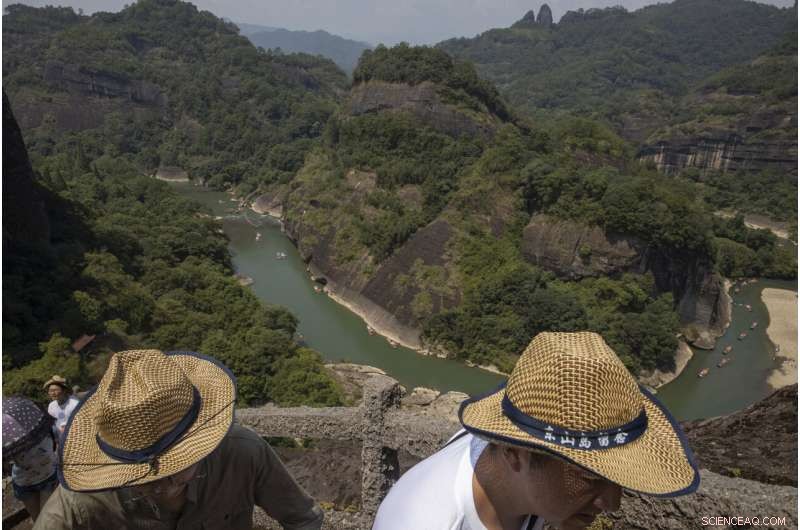
Visitors climb Tianyou peak in Wuyishan in eastern China's Fujian province on Wednesday, Aug. 14, 2019. The ambition to create a unified park system represents "a new and serious effort to safeguard China's biodiversity and natural heritage, " says Duke University ecologist Stuart Pimm. (AP Photo/Ng Han Guan)
-

Women work on a photo for their tea products on a mountain top in Wuyishan in eastern China's Fujian province on Wednesday, Aug. 14, 2019. Zhu Chunquan, the China representative of the International Union for the Conservation of Nature, a Switzerland-based scientific group, notes that the country's economy has boomed over the past 40 years. But priorities are now expanding to include conserving the country's key natural resources. "It's quite urgent, as soon as possible to identify the places, the ecosystems and other natural features" to protect, Zhu says. (AP Photo/Ng Han Guan)
-
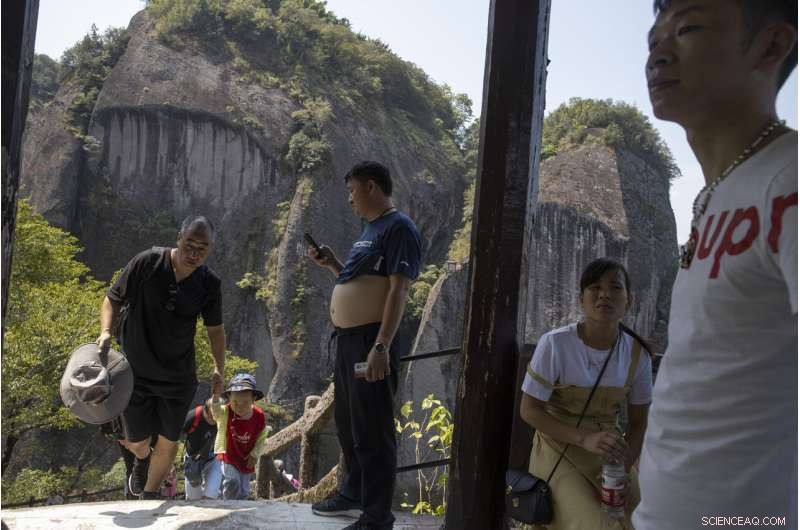
Visitors rest in a pavilion during a climb up Tianyou peak in Wuyishan in eastern China's Fujian province on Wednesday, Aug. 14, 2019. (AP Photo/Ng Han Guan)
-
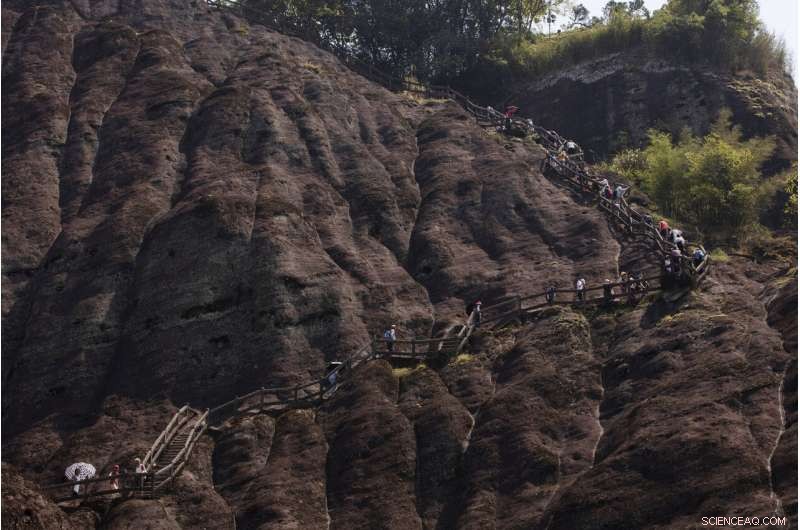
Visitors climb Tianyou peak in Wuyishan in eastern China's Fujian province on Wednesday, Aug. 14, 2019. (AP Photo/Ng Han Guan)
-
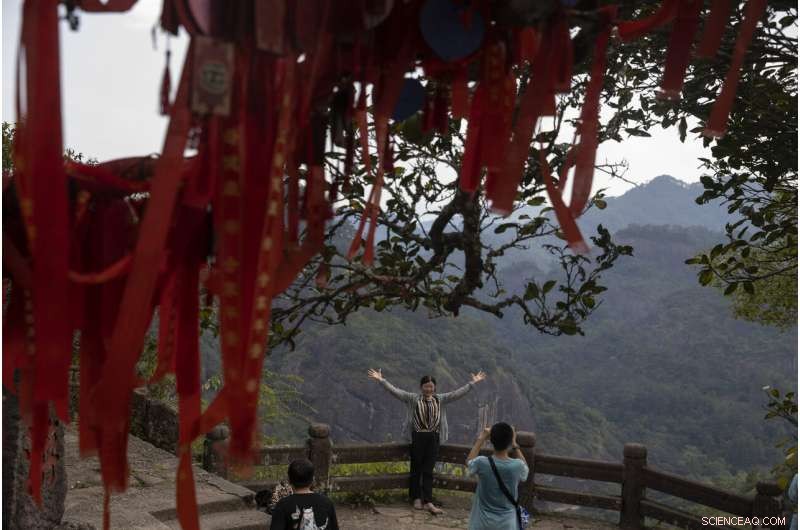
A visitor poses for a photo on Tianyou peak in Wuyishan in eastern China's Fujian province on Wednesday, Aug. 14, 2019. (AP Photo/Ng Han Guan)
-
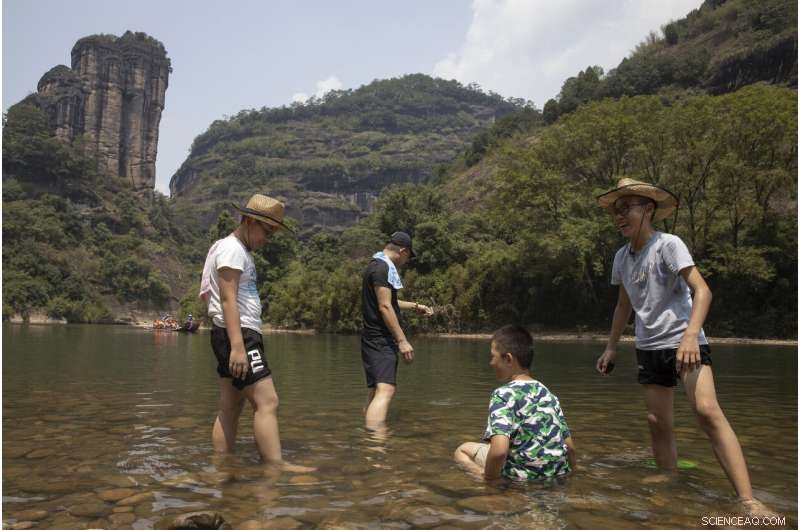
A woman poses for photos near a waterfall in Wuyishan in eastern China's Fujian province on Thursday, Aug. 15, 2019. (AP Photo/Ng Han Guan)
-

Tourists stand in shallow water along the Nine Bends River in Wuyishan in eastern China's Fujian province on Thursday, Aug. 15, 2019. (AP Photo/Ng Han Guan)
-
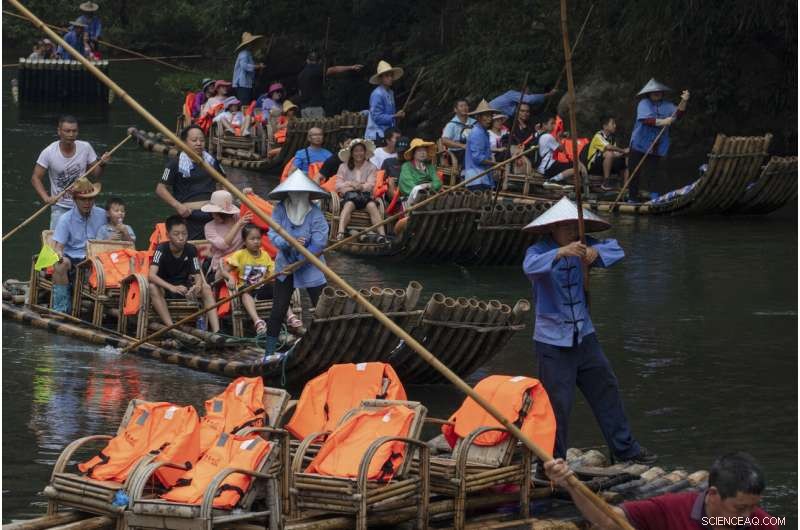
Tourists ride in bamboo rafts during a tour of the Nine Bends River in Wuyishan in eastern China's Fujian province on Thursday, Aug. 15, 2019. In August 2019, policymakers and scientists from China, the United States and other countries met in China to discuss the country's plans to create a unified park system with clear standards for limiting development and protecting ecosystems. (AP Photo/Ng Han Guan)
-

A boy holds a water rifle on the banks of the Nine Bends River as bamboo raft operators wait for tourists in Wuyishan in eastern China's Fujian province on Thursday, Aug. 15, 2019. Zhu Chunquan, the China representative of the International Union for the Conservation of Nature, a Switzerland-based scientific group, notes that the country's economy has boomed over the past 40 years. But priorities are now expanding to include conserving the country's key natural resources. "It's quite urgent, as soon as possible to identify the places, the ecosystems and other natural features" to protect, Zhu says. (AP Photo/Ng Han Guan)
Now Ouyang is drawing upon that work, combined with surveys of more than 1, 500 species of endangered and threatened plants and animals, to map priority areas for conservation and advise park planners. He is focusing on habitats of endangered species that live only in China.
"If we lose it here, it's gone, " hij zegt.
The first parks to be formally incorporated into China's national park system will showcase the country's vast and varied landscapes and ecosystems—from the granite and sandstone cliffs of Wuyishan in eastern China to the lush forests of southwestern Sichuan province, home to giant pandas, to the boreal forests of northeastern China, where endangered Siberian tigers roam.
When it comes to ecology, few countries have more to lose, or to save, than China.
"A huge country like China literally determines the fate of species, " says Duke University's Pimm.
© 2019 The Associated Press. Alle rechten voorbehouden.
 Nanocilindervibraties helpen bij het kwantificeren van polymeeruitharding voor 3D-printen
Nanocilindervibraties helpen bij het kwantificeren van polymeeruitharding voor 3D-printen Chemici brengen gemengde gevouwen eiwitten tot leven
Chemici brengen gemengde gevouwen eiwitten tot leven Materialen voor medische jassen ondergaan strenge tests
Materialen voor medische jassen ondergaan strenge tests Vervuilers, ziekteverwekkers kunnen samenwerken om ons ziek te maken
Vervuilers, ziekteverwekkers kunnen samenwerken om ons ziek te maken Met 2D-materialen kunnen elektrische voertuigen 500 mijl afleggen op één lading
Met 2D-materialen kunnen elektrische voertuigen 500 mijl afleggen op één lading
Hoofdlijnen
- Waarom zijn de roze meren van Australië roze?
- Verouderd DNA kan genen anders activeren
- Welke drie organellen hebben DNA?
- Tandwortelpulp wordt een rijke bron van stamcellen
- Typen cellijnen
- Belangrijke feiten over het koninkrijk Monera
- Mysterieuze nieuwe zeebodemsoorten werpen licht op vroege evolutie van dieren
- Heeft Kelp veel verschillende cellen?
- Robotapparaat volgt plantengroei op cellulair niveau
 Storm teistert Caribisch gebied met harde wind, regen op weg naar de VS
Storm teistert Caribisch gebied met harde wind, regen op weg naar de VS Brazilië accepteert vliegtuigen uit Chili om Amazonebranden te bestrijden
Brazilië accepteert vliegtuigen uit Chili om Amazonebranden te bestrijden TACC COVID-19 twitter-dataset maakt sociaalwetenschappelijk onderzoek naar pandemie mogelijk
TACC COVID-19 twitter-dataset maakt sociaalwetenschappelijk onderzoek naar pandemie mogelijk De borstelharen van polyelektrolytborstels opfleuren en krimpen
De borstelharen van polyelektrolytborstels opfleuren en krimpen Flipboard voegt maandelijks abonnement toe om video-nieuwsclips zonder advertenties van smartphones te bekijken
Flipboard voegt maandelijks abonnement toe om video-nieuwsclips zonder advertenties van smartphones te bekijken Inertiële opsluiting fusie-implosies hebben significante 3D-asymmetrieën
Inertiële opsluiting fusie-implosies hebben significante 3D-asymmetrieën Hoe uw oscilloscoop te kalibreren
Hoe uw oscilloscoop te kalibreren  Koud, droge klimaatveranderingen gekoppeld aan de verdwijning van Neanderthalers
Koud, droge klimaatveranderingen gekoppeld aan de verdwijning van Neanderthalers
- Elektronica
- Biologie
- Zonsverduistering
- Wiskunde
- French | Italian | Spanish | Portuguese | Swedish | German | Dutch | Danish | Norway |

-
Wetenschap © https://nl.scienceaq.com

